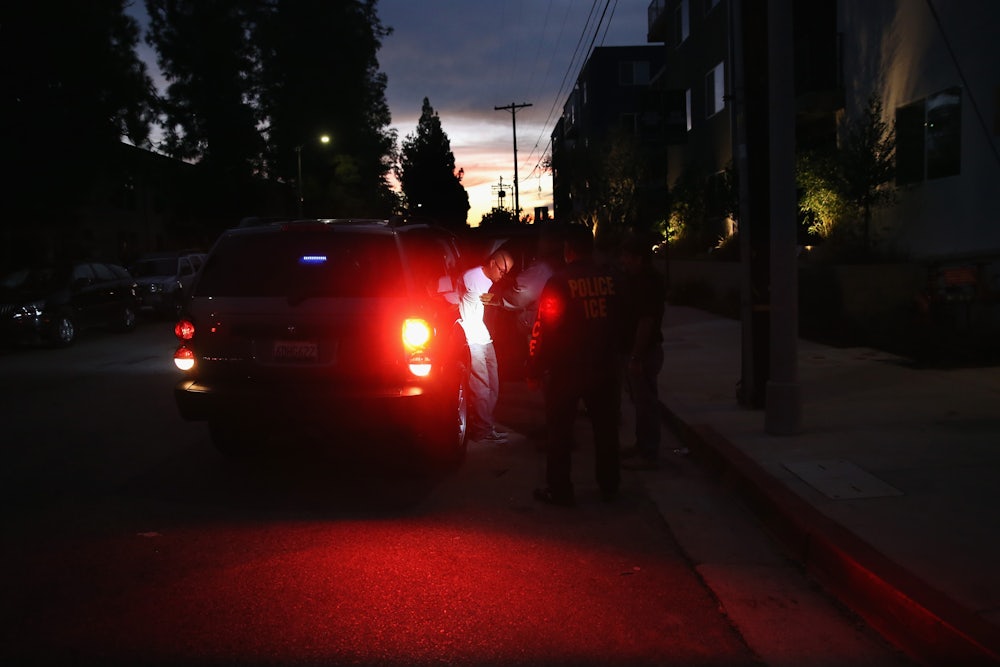As debate in Washington intensifies over the fate of undocumented Dreamers, another immigration battle has been playing out on the ground in cities and states around the country. Numerous metropolitan areas, including New York, Los Angeles, Baltimore, and Washington, have declared themselves “sanctuary cities,” and vowed that local law enforcement will not assist in Donald Trump’s immigration crackdown. In response, the president has threatened to withhold millions of dollars in federal funds from these cities and made a point of targeting them with immigration raids.
But even as dominantly liberal cities have resisted the president on this issue, many other local and state jurisdictions have embraced the agenda of deporting undocumented immigrants. This spring, conservative Texas Governor Greg Abbott signed a bill, Senate Bill 4, that effectively outlaws sanctuary cities in the state and allows local police to question the immigration status of anyone they detain or arrest. The law also directs local officials to cooperate with federal immigration agents and threatens those who don’t comply with jail time and fines of up to $25,500 per day. In August, a federal judge temporarily blocked the new law, but Texas has vowed to appeal.
Moreover, local sheriff’s offices have been volunteering to partner with federal authorities as part of the government’s 287(g) program, which allows local police to act as federal immigration officers and lead raids and initiate deportations. The program began in 1996 and grew in scope during George W. Bush’s presidency. Barack Obama, whose administration deported more people than any in American history, also expanded the program before scaling it back dramatically, citing ineffectiveness and abuse.
Shortly after entering office, however, Trump ordered the 287(g) program’s expansion once again. Since then, it has nearly doubled in size, from 31 participating agencies in 16 states to 60 agencies in 18 states. Texas has led the way, with 17 counties joining the program this year. In its current form, local police check a federal database to see if people they’ve arrested are undocumented; if they are, the police notify Immigration and Customs Enforcement. “I’m proud to stand alongside these sheriffs who are taking decisive action to join ICE in an important effort to enhance the safety of their communities,” said Thomas Homan, the acting director of ICE, in July.
The program is hardly limited to Texas. Police departments in parts of California, New Jersey, Massachusetts, Florida, and other states have all joined the program. While sanctuary cities like Los Angeles, New York, and Miami have garnered political and media attention, they all have neighboring anti-sanctuary counties.
Number of sheriff’s offices working with ICE, by state:
Alabama: 1
Arizona: 4
Arkansas: 2
California: 1
Florida: 4
Georgia: 4
Louisiana: 1
Maryland: 3
Massachusetts: 3
Nevada: 2
New Jersey: 4
North Carolina: 5
Ohio: 1
Oklahoma: 1
South Carolina: 4
Tennessee: 1
Texas: 18
Virginia: 1
For some local sheriffs, aligning themselves with Trump can pay off. While the president is working to punish sanctuary cities, the federal government has awarded generous payouts to some counties that participate in the 287(g) program for holding undocumented immigrants on behalf of ICE—$20.5 million to New Jersey’s Hudson County, for example, for services rendered in 2015.
Appealing to nativist sentiment can also help local authorities boost their popularity by helping them appear tough on crime. In Massachusetts, for instance, Bristol County Sheriff Thomas Hodgson is a fierce supporter of Trump’s hard-line approach to immigration and has even offered to send inmates to the U.S.-Mexico border to help the president build his wall.
Such forceful approaches have opened the 287(g) program to abuse, however. One of its most prominent supporters was Joe Arpaio, the former sheriff of Maricopa County, Arizona, whose racial profiling and mistreatment of prisoners eventually led the Obama administration to scale back the 287(g) program. But as Trump’s decision to pardon Arpaio has emphasized, the current president has no such qualms.
Far from being a “commonsense” approach to immigration enforcement, as the Trump administration claims, however, the 287(g) program may actually make communities less safe, by shifting the focus away from run-of-the-mill crimes and fracturing the trust between local police and immigrants in their communities. Already, there’s evidence that immigrants are reporting fewer crimes since Trump became president. In May, an analysis by the web site FiveThirtyEight suggested that crime reports from Latinos in Philadelphia and Denver fell between 4 percent and 12 percent in the first few months of 2017. And a report this year from Professor Tom Wong of the University of California, San Diego, found that large sanctuary cities are safer, on average, than non-sanctuary cities.
But we can see the rise of sanctuary cities and the reemergence of 287(g) as two effects of the same phenomenon: As America grows more polarized, urban areas are becoming more pro-immigrant, while rural areas are becoming more nativist. Trump may have galvanized sanctuary cities to resist his immigration policies. But he’s also enabled jurisdictions where anti-immigrant sentiment runs high to make deportations the top priority—at the expense of safety and security.
